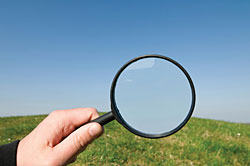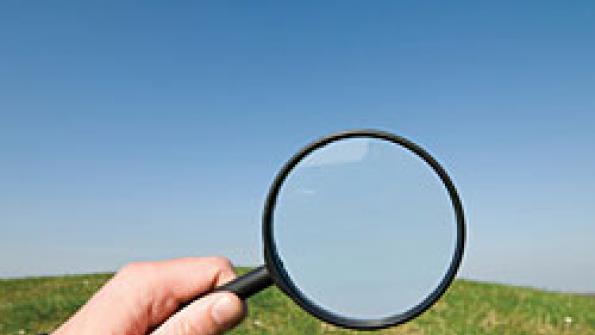In search of green clarity
Driven by city and county managers, today’s government purchasers are asking for greener products and services and, as a result, suppliers have responded with a growing assortment of environmental claims — ranging from “Earth Friendly” to “Mother Earth Approved” to “Green Certified.” But with manufacturers selecting from more than 500 green labels to claim their environmental bona fides — according to www.ecolabelling.org, a website that tracks environmental labeling — how does government even begin to determine which ones are legitimate?
Not all claims are alike

First, understand the difference between standards, certifications, verifications and labels. Often mistakenly used interchangeably, there are important distinctions.
Standard — A standard is a specification document that establishes the environmental and human health parameters a product or service must meet to be considered a greener offering. It establishes clear thresholds and requirements, such as minimum recycled-content percentages, energy- or water-efficiency requirements, toxicity tests and volatile organic compound limits. A well-written standard clarifies what is required.
Certification — A certification is proof from an independent third-party that a particular product or service meets a specific standard. It provides assurance that a product actually delivers the benefits it claims.
Verification — Verification means an independent third-party has determined that a specific environmental claim (such as the product contains X percentage of postconsumer recycled content or Y percentage of biobased content) is accurate. Verification is another way of providing proof that a product delivers on its claimed environmental benefits. Verification to a specific standard results in certification.
Label — A label is an identifying mark used by suppliers to draw attention to the environmental benefits of a product or a service. While some labels are based on being certified to a standard, other labels are awarded based on an individual’s or organization’s professional judgment, based on membership with a specific trade association, or created by a supplier’s marketing department. A label is not particularly meaningful unless a rigorous verification or a standards-based certification program supports it.
Confusion continues about the differences between standards, certifications, verifications and labels because North America’s two oldest, most established environmental leadership standards — EcoLogo and Green Seal — are ISO Type I environmental labeling programs. Type I programs combine standard setting, certification and labeling into a single entity.
Some suppliers are exploiting that confusion by creating their own labels identifying greener products without providing much clarity about what the label means, which products are eligible for it, or how a product demonstrates compliance.
Other labeling programs, such as U.S. Environmental Protection Agency’s (EPA) Design for the Environment (DfE) program, are not standards-based programs and instead award the DfE label based on internal EPA analysis. The Cradle to Cradle (C2C) label, similarly, is based on a consulting firm’s professional assessment instead of a specific standard. While those programs and other similar approaches are identifying greener products, the lack of an accompanying standard makes them challenging for government purchasing.
Efforts to bring green clarity
Recognizing the increasing confusion in the ways suppliers are marketing greener products, government purchasers and others are working to make it easier for purchasing professionals and consumers to buy greener products. A few of the efforts underway include:
Green Products Roundtable — GPR is a group of greener purchasing experts representing government purchasers, a few suppliers (such as Office Depot, Staples, and Best Buy), the EPA, industry, and the environmental standard-setting, certification and labeling community. One of GPR’s primary objectives is to make it easier for institutional purchasers to identify greener products.
GPR also aims to improve the quality of green claims, improve education and communication on environmental claims and examine options to better coordinate efforts among the various environmental standard-setting, certifying and labeling organizations.
Energy Star — In April, the Energy Star program announced that it would significantly revamp its verification procedures. Responding to criticism from professional purchasers and others, the Energy Star program said it will now require companies to provide proof that products meet the Energy Star criteria before permitting them to use the Energy Star label.
Previously, manufacturers could make Energy Star claims without submitting proof. Several independent government reviews found significant flaws with the procedures Energy Star was using, including approving Energy Star labels for fake products, such as a gasoline-powered alarm clock. Until the Energy Star program completes its procedural improvements, government purchasers are encouraged to continue asking suppliers for independent verification of Energy Star claims. (See “Specifying greener products” sidebar.)
Federal Trade Commission — The Federal Trade Commission (FTC) enforces federal government truth-in-advertising laws. It also publishes guidance on appropriate environmental marketing claims known informally as the Green Guides.
After a long period from 2000 to 2009 in which FTC did not take any enforcement actions on potentially misleading environmental claims, the agency recently has been targeting blatant violations of the Green Guides. Several companies have been fined for making misleading claims about textile products supposedly made from bamboo and for making misleading biodegradability claims.
As FTC pointed out, products labeled biodegradable are misleading if the claim leads consumers to believe the products will degrade using traditional disposal methods. Biodegradable products do not degrade in landfills, which is where most products ultimately are disposed. As a result, any biodegradability claim must be accompanied by qualifying language explaining the circumstances under which the product will degrade, along with relevant, scientific tests supporting the claim.
The FTC released proposed revisions to the Green Guides in early October. The proposed revisions include greater clarity around a number of environmental claims, including suggestions of increased scrutiny of environmental labels.
Copies of the current Green Guides and additional background information is available on the FTC website at www.ftc.gov/opa/reporter/greengds.shtm.
Dot Eco — A new Internet domain extension (similar to .gov or .com) that would become a source for verified environmental information on products, services and companies.
Sustainability Consortium — A group of academics, retailers, purchasers and others attempting to create a system to track environmental costs and benefits throughout the supply chains supporting the entire global economy.
Green Products Innovation Institute — An effort led by California, Google, Walmart, YouTube, Brad Pitt and others to create a new system or label to identify greener products.
Underwriters Laboratories Environment (UL Environment) — Launched two years ago, UL Environment has begun developing environmental leadership standards and certifying products meeting its standards and selected standards developed by others. With the backing of Underwriters Laboratories (UL), a 115-year old standard-setting and certification organization best known for its ubiquitous safety standards, UL Environment appears poised to become a significant player in the environmental standards and certification world.
Tools available now
Governments have created new tools to help make greener purchasing easier. Some recent examples include:
Commonwealth of Pennsylvania Green Purchasing Video — Designed to encourage Commonwealth agencies and all purchasing professionals to buy greener products, the Emmy award-winning, 15-minute video highlights the legal, professional, and environmental reasons for doing so. An online version is available at www.gggc.state.pa.us/portal/server.pt/community/procurement/13831. DVD versions also are available.
New York State Green Cleaning Program — The New York State Office of General Services has created a website that makes it easy to buy greener cleaning products and implement a greener cleaning program. It identifies benefits, best practices, a list of approved products, documents, templates and a series of education videos to make it easier to implement a successful program.
Additional tools are available on the websites of the National Institute of Governmental Purchasing and National Association of State Procurement Officials.
It is clear to everyone attempting to buy, sell or define greener products that there is still a need for greater clarity. Federal, state and local governments are playing an active role in creating the necessary improvements. Controlling billions of dollars in purchasing power means having a significant voice in determining which solutions ultimately prove viable. Government purchasers, with the support and leadership of city and county officials, can cast a vote for the future with every purchase.
- Read the “Specifying greener products” sidebar to learn about requiring in contracts that products be certified to specific standards.
Scot Case ([email protected]) works with Northbrook, Ill.-based UL Environment.
Editor’s Note: This article is based on one that appeared in Government Procurement, www.govpro.com, a sister publication of American City & County.




















